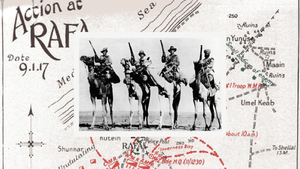The Battle of Rafa: The Role of the Imperial Camel Corps
The Battle of Rafa, fought on January 9, 1917, stands as a significant episode in World War I, highlighting the strategic ingenuity and tenacity of the Allied forces, including the crucial involvement of the Imperial Camel Corps.
The Imperial Camel Corps, formed in 1916, was an allied unit comprising soldiers from Britain, Australia, New Zealand, and India. They were specifically assembled to operate in the harsh desert conditions of the Middle East. Camels, known for their endurance and ability to navigate difficult terrain, were the ideal choice for transport in these arid regions.

Guerrilla Operations 1918. Part of the Douglas Pearman Collection © IWM Q 105525
The Battle of Rafa: A Turning Point
The Battle of Rafa, fought on January 9, 1917, was part of the broader Sinai and Palestine Campaign. The objective was to defeat the Ottoman forces entrenched at Rafa, located on the border of the Sinai Peninsula and Palestine, thus securing the region for the Allies.
A mere three miles south of Rafa, the Turkish forces, numbering around 2,000, had fortified themselves at El Magruntein, utilizing the natural elevation of Hill 255. This stronghold was a formidable barrier for the advancing Allied troops.
As dawn broke on January 9th, a combined force comprising the Australian and New Zealand Mounted Division, the 5th Mounted Brigade, and three battalions of the Imperial Camel Corps Brigade approached Rafa. Their first strategic move was to isolate the garrison at El Magruntein by cutting off the telegraph lines to Gaza, effectively severing their communication.

Map depicting the Battle of Rafa. Powles, C. Guy (1922).
The New Zealand Mounted Rifles Brigade was tasked with manoeuvring to the south, preparing to launch an attack from the east and north. Concurrently, the 5th Mounted Brigade positioned itself to strike from the west. The coordinated offensive commenced at 7 am with a heavy artillery bombardment targeting the Turkish redoubts.
The Allied advance across the open ground towards the Turkish positions was met with fierce resistance. The Turks managed to maintain a high rate of fire, significantly slowing down the Allied assault. By early afternoon, the British and Commonwealth forces were starting to experience a critical shortage of ammunition.

The New Zealanders in Sinai and Palestine Volume III Official History New Zealand's Effort in the Great War. Auckland, Christchurch, Dunedin and Wellington: Whitcombe & Tombs Ltd, p73).
Aware of an approaching Turkish relief force, the Allied commanders contemplated a retreat to El Arish. However, as the day progressed towards evening, several units, determined not to let victory slip away, initiated a series of bold attacks. Notably, three regiments from the New Zealand Mounted Rifles Brigade charged from the north, directly assaulting the main redoubt on Hill 255. They were robustly supported by the Imperial Camel Corps and the Australian Light Horse regiments. This concerted effort finally broke the Turkish resistance, leading to widespread surrenders.
The Battle of Rafa inflicted heavy losses on the Turkish side, with approximately 200 killed, a similar number wounded, and around 1,500 captured. Despite the victory, the Allied forces remained vigilant against the potential threat of the Turkish relief column and began to withdraw towards El Arish. The defeat at Rafa made the Turkish command rethink their strategy, leading them to abandon their forward positions outside Gaza, fearing isolation of their garrisons.

Captured Turkish prisoners in a temporary compound at El Arish after having been captured at Rafa. (AWM A02391)
The Role of the Imperial Camel Corps
Tactical Mobility: The camels provided unparalleled mobility across the desert, allowing the Corps to execute rapid and unexpected manoeuvres. This mobility was crucial in outflanking Ottoman positions.
Endurance in Harsh Conditions: The soldiers of the Camel Corps were trained to endure extreme conditions, making them invaluable in a battle where traditional military units would struggle.
Surprise Attacks: Their ability to traverse unorthodox routes enabled them to launch surprise attacks, disorienting the Ottoman forces.
Versatility in Combat: Despite their primary role as a mobile unit, members of the Camel Corps were also skilled in infantry tactics. During the Battle of Rafa, they dismounted and engaged in direct combat, showcasing their versatility.
The Outcome and Legacy
The Battle of Rafa concluded with the Allies capturing the position, a victory that was instrumental in the subsequent fall of Gaza. The success of the Imperial Camel Corps not only demonstrated the effectiveness of unconventional military units but also highlighted the importance of adapting to the environmental challenges of warfare.
The Imperial Camel Corps' involvement in the Battle of Rafa is a testament to the innovation and adaptability of military strategy during World War I. Their contribution, although not as widely recognized as that of traditional infantry or cavalry units, was essential in the dynamics of desert warfare and the eventual Allied success in the Middle Eastern theatre of the war.
https://www.westernfrontassociation.com/world-war-i-articles/the-action-at-rafa-9-january-1917/
https://www.awm.gov.au/collection/PL1267

